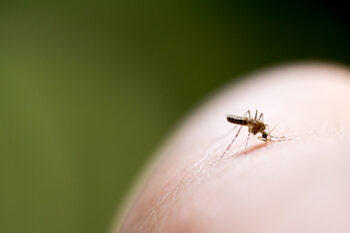Top 5 Things to Know about Malaria, According to a Seattle Children’s Infectious Disease Researcher
7.25.2023 | Colleen Steelquist
 Eight cases of locally acquired malaria have been confirmed in Florida and Texas this summer, marking the first time in 20 years locally transmitted cases have been seen, and decades since malaria was officially eradicated in the United States.
Eight cases of locally acquired malaria have been confirmed in Florida and Texas this summer, marking the first time in 20 years locally transmitted cases have been seen, and decades since malaria was officially eradicated in the United States.
Although about 2,000 Americans are diagnosed with malaria each year, those cases are linked with travel outside the U.S.
While no one enjoys the itchy annoyance of a mosquito bite, is there a reason to be concerned? On the Pulse asked Seattle Children’s Research Institute’s Dr. Alexis Kaushansky, a malaria expert in the Center for Global Infectious Disease Research, to weigh in.
1. Should parents be worried about rising malaria cases in the U.S.?
Dr. Kaushansky: On a personal level, I’m not worried — the local risk is very low. This is not the sort of scenario in the U.S. where we’re advising people not to leave their houses. At this point, I would not put my kids on malaria prevention medicine if we traveled to Florida. I understand the unease, but we have strong public health systems in this country.
Also, given the Pacific Northwest climate, it is quite unlikely that these mosquitoes are going to end up in high prevalence here anytime soon. We would all be very surprised if we saw a locally acquired malaria case in Seattle. But historically, there was malaria in the Northwest, and it led to pushes for spraying for mosquitoes and getting rid of standing water. There are surveillance efforts that monitor this.
However, on a global level, I am deeply concerned about the spread of malaria and other vector-borne diseases to new areas of the world. The World Health Organization reported 247 million malaria cases worldwide in 2021, and an estimated 619,000 malaria deaths — largely in kids and pregnant persons — after years of declining deaths from malaria. That partly stems from infection control efforts focused on other things, like the COVID-19 pandemic, in addition to changing climates that alter the habitat for mosquitoes that carry malaria.
2. Why do you think locally acquired malaria cases have occurred, and what are some avoidance measures?
 Alexis Kaushansky, PhD, principal investigator in Seattle Children’s Center for Global Infectious Disease Research
Alexis Kaushansky, PhD, principal investigator in Seattle Children’s Center for Global Infectious Disease ResearchDr. Kaushansky: Those of us who study malaria have known it’s coming for a long time. Malaria always transmits mosquito to human, never human to human or mosquito to mosquito; to have malaria transmission, you need both hosts.
Due to climate change, there are more and more mosquitoes that could transmit malaria in different parts of the globe, including in the hot, humid parts of the United States where mosquitoes are happiest.
The classic avoidance measures are wise: Use bug spray, wear long pants and sleeves, particularly if you are outside at night, sleep in areas with window screens and close your tent if you’re camping.
3. Do most mosquitoes carry the parasite that causes malaria?
Dr. Kaushansky: No, most mosquitoes do not carry the parasite. Only a subset of a specific type of mosquito, called Anopheles, transmits malaria.
We have Anopheles mosquitoes in the Pacific Northwest, but they do not carry the parasite. That small subset are all nighttime biters, so if you get bit by a mosquito in the middle of the day, that is not one that would carry malaria.
The species of malaria that is currently being seen in Florida and Texas is Plasmodium vivax, a less deadly form of malaria than Plasmodium falciparum, which is found mostly in Southeast Asia and Africa.
4. What are symptoms of malaria, and what should parents do if they see such symptoms?
Dr. Kaushansky: The main symptom is a cyclic fever — one that’s on and off— and the sorts of things you associate with a high fever, like chills, headache, muscle aches and fatigue. The symptoms can vary dramatically from person to person. For some kids, it’s mild like the flu, and for others, it’s much more severe and can lead to coma and even death. Understanding why there are differences in symptoms is an active area of research.
Any time your child has a high fever, you should see a healthcare provider. And certainly let the provider know if you’ve traveled to a malaria-endemic area.
5. How does this point to the importance of eradicating malaria everywhere?
Dr. Kaushansky: No children anywhere in the world deserve to have malaria or should have to worry about dying from an infectious disease. It doesn’t have to cross U.S. borders for it to be important for us to work on something that impacts kids and affects health so dramatically.
It is also to our benefit as citizens of the globe to understand any infectious disease present anywhere in the world could travel to the U.S. Sometimes having things occur own within our own country serves as a powerful reminder of what others are experiencing around the planet.